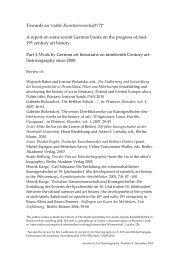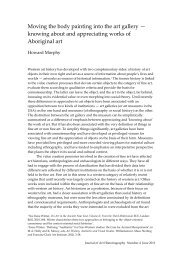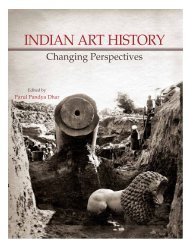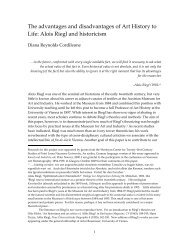9/CCG1 - Journal of Art Historiography
9/CCG1 - Journal of Art Historiography
9/CCG1 - Journal of Art Historiography
You also want an ePaper? Increase the reach of your titles
YUMPU automatically turns print PDFs into web optimized ePapers that Google loves.
Carolyn C. Guile<br />
Winckelmann in Poland: An Eighteenth-Century<br />
Response to the ‘History <strong>of</strong> the <strong>Art</strong> <strong>of</strong> Antiquity’<br />
monumental sizes <strong>of</strong> those in Babylon.’ 78 It is notable that Potocki analyzes the art <strong>of</strong><br />
east and west extensively and with deliberate attention to his perception <strong>of</strong> cultural<br />
fault lines.<br />
To demonstrate further his views concerning the superiority <strong>of</strong> broadly<br />
western art, he presented expanded analyses <strong>of</strong> the art <strong>of</strong> civilizations outside a<br />
western purview not treated by Winckelmann; for example, the Chinese and the<br />
Indian are given discreet chapters. Potocki’s assessment <strong>of</strong> Chinese art was that it<br />
had reached a point <strong>of</strong> stagnation and had not changed much over time. He held<br />
this observation as general, visible pro<strong>of</strong> <strong>of</strong> the lack <strong>of</strong> progress in the arts that he<br />
deemed particular to eastern peoples. By extension, this was for him the key that<br />
separated and distinguished the east from the west in general. 79 Interestingly, the<br />
discussion <strong>of</strong> Chinese art addresses the technology <strong>of</strong> art as it relates to the concept<br />
<strong>of</strong> imitation and mass production, as well as to borrowing and originality. Where<br />
the imitation <strong>of</strong> Nature served as the foundation for western art, the fabrication <strong>of</strong><br />
copies per se was China’s habit, and characterized Chinese arts, Chinese curiosity,<br />
and Chinese patterns <strong>of</strong> behaviour. 80 On Indian arts, Potocki declared that they<br />
showed evidence <strong>of</strong> stasis:<br />
The Indians <strong>of</strong> today do not sculpt in the rocks those amazing<br />
edifices called the pagodas, <strong>of</strong> which you can find ancient traces<br />
because their beautiful and rich country for a long time now has been<br />
the booty <strong>of</strong> the Mohammetan and European conquerors. But their<br />
art will always be a part <strong>of</strong> their whole. This country civilized for a<br />
thousand years has not taken a single step in art; though less<br />
enormous in its production, it is by many measures what it used to<br />
be. 81<br />
Europe, by contrast, underwent a drastic change beginning in the fifteenth<br />
century, ‘waking up from a long period <strong>of</strong> barbarity’ and ‘stepping rapidly toward<br />
perfecting itself.’ 82<br />
Potocki in effect adopted Winckelmann’s system in order to demonstrate its<br />
wider applicability. That the existence <strong>of</strong> cultural fault lines interested Potocki and<br />
his colleagues greatly is critical to understanding his point <strong>of</strong> view. His deliberate<br />
78 ‘Stąd mniemać wypada, że persopolitańskie ruiny mogą nam niejako służyć za naoczne wyobrażenie<br />
sztuki chaldejskiej i wskazać smak, w jakim babilońskie gmachy przyozdobione były.’ Potocki, O<br />
Sztuce u Dawnych, 1: 101.<br />
79 Potocki, O Sztuce u Dawnych, 1: 79.<br />
80 Potocki, O Sztuce u Dawnych, 1: 135-85.<br />
81 Indianie dzisiejsi już nie kują w skałach tych zdumiewających gmachów, pagodami zwanych, jakich<br />
się u nich odwieczne znajdują ślady, bo piękna i bogata ich kraina stała się od dawna łupem<br />
mahometańskich i europejskich najezdników lecz sztuka ich co do innych części zawsze jest jedną.’<br />
Potocki, O Sztuce u Dawnych, 1: 78.<br />
82 ‘Od XV wieku Europa z długiego ocucona barbarzyństwa, śpiesznym krokiem ku udoskonaleniu<br />
dążyła.’ Potocki, O Sztuce u Dawnych, 1: 79.<br />
21
















